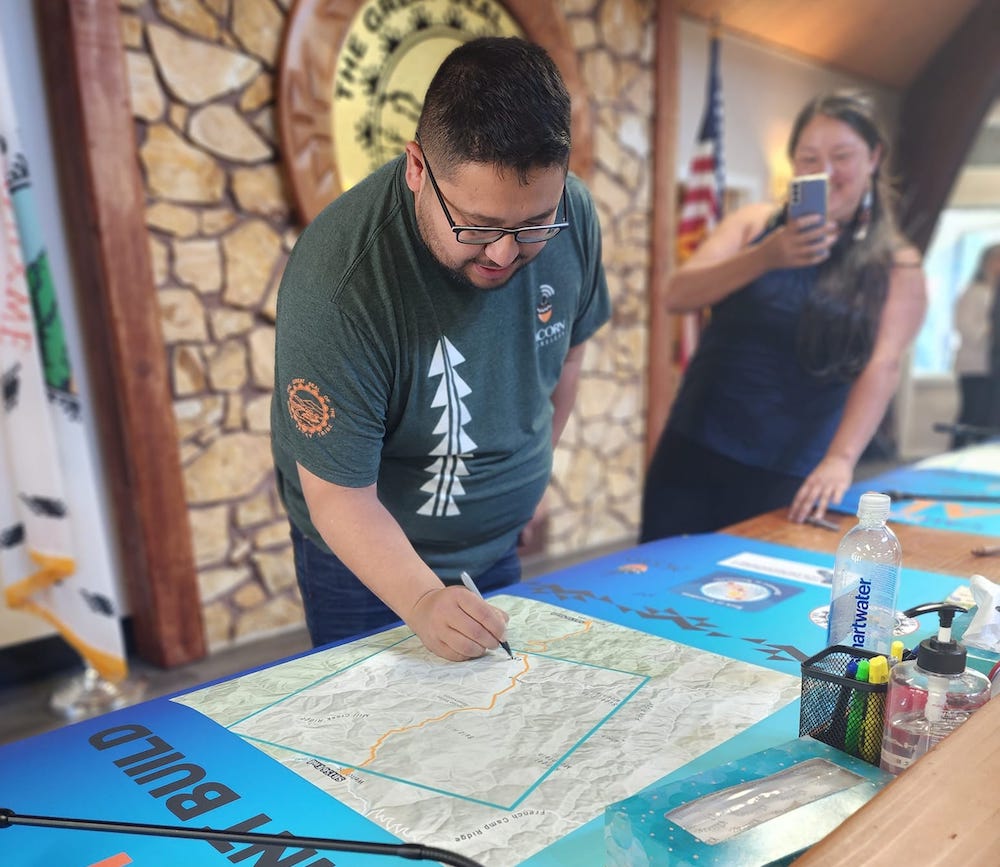
- Details
- By Chez Oxendine
- Economic Development
More than a quarter of California’s households lack internet access, per a report from the California Public Utilities Commission published in 2021. Many of those households are Native people located in rural areas where middle-mile fiber is expensive because of geographic and infrastructure challenges.
The Hoopa Tribe in northern California believes it can make broadband more accessible and affordable throughout the region thanks to a new partnership that could be a model for other tribes.
Fresh off of a $65 million cash infusion by the National Telecommunications and Information Administration (NTIA) Tribal Broadband Connectivity Program Grant, the Hoopa Tribe has partnered with the state of California to jointly build 23 miles of fiber construction on Hoopa tribal lands.
The state is effectively paying $10.25 million toward the build, expanding the buildout already under way, according to Hoopa Valley Public Utilities District General Manager Linnea Jackson. The agreement came about through collaborative work by the California Department of Technology, the Hoopa Valley Public Utilities District (HVPUD), and the Corporation for Education Network Initiatives in California’s Golden State Network program.
It’s the first such partnership in the country, and hopefully the start of a paradigm shift in how states see Native American internet providers, Jackson told Tribal Business News.
“Tribes are not set up like a private, for-profit business,” Jackson said. “So I think there’s going to have to be some changes in how they define what a provider looks like, especially in tribal lands. Hopefully this agreement will be the start of many (others) between states and tribes as providers, and investing back into tribal organizations rather than these outside telecom companies.”
 Linnea Jackson, HVPUD The partnership itself could ripple out into other areas of state-tribe relationships, in particular with the Broadband, Equity, Access, and Deployment (BEAD) program, which the NTIA rolled out this summer. That program delivered $42.5 billion to all 50 states, leaving each state to further distribute the money into subgrants for broadband infrastructure development.
Linnea Jackson, HVPUD The partnership itself could ripple out into other areas of state-tribe relationships, in particular with the Broadband, Equity, Access, and Deployment (BEAD) program, which the NTIA rolled out this summer. That program delivered $42.5 billion to all 50 states, leaving each state to further distribute the money into subgrants for broadband infrastructure development.
Tribes have expressed concerns about accessing the BEAD money, which could go a long way toward closing a yawning gap in Indian Country broadband funding. Scattershot support and small tribal set-asides exist within a variety of federal programs, but the largest tribal-specific effort has been the Tribal Broadband Connectivity Program (TBCP). That initiative leveraged nearly $3 billion toward tribal broadband, but the need is likely closer to $10 and $11 billion, according to prior Tribal Business News reporting.
That’s reflected even in the Hoopa tribe’s needs: its $65 million award through the TBCP helps, but doesn’t complete the amount of work that’s necessary to get the whole reservation online, Jackson said. Moreover, money gets even tighter when figuring in the kind of research and resources necessary to turn the new infrastructure into a revenue resource capable of sustaining itself.
“I know that that sixty-five million sounds like a lot of money, but also within the state of California, everything's more expensive — fuel, energy, all up and down the supply chain, “ Jackson said. “It kind of blows my mind that the government's going to invest this money, but then also not see the parallel components that are also needed for business development, sustainability, offsets and resources that are gonna be needed to make this all sustainable.”
Alongside gaps in funding are gaps in policy. For example, tribal providers don’t receive the same development offsets that a larger telecommunications company might receive on a similar investment, Jackson said. Closing those gaps through policy updates would be as crucial to making tribal providers like the HVPUD into sustainable, long term enterprises, she added.
“You’ve got larger providers who are given funding to provide connectivity within a service area or census block,” Jackson said. “When I talk about policy changes, that’s one of the changes that are going to have to happen. That money should be coming to tribal providers who are providing that service within their areas, so that we’re treating them apples to apples as we would other providers.”
Still, Jackson said she is encouraged by the actions the state of California has taken, including the build-out partnership and regional meetings with tribes across the state.
“There’s roughly 20% of the (country’s) 574 federally recognized tribes in this state, so we have a lot of leverage, in a way,” Jackson said. “I think California is being very progressive now, so we’ll be having a meeting to talk with them about how we can be allocated some of that BEAD funding, although it isn’t expressly written for tribes.”
In the meantime, HVPUD continues to grow, slowly but surely, Jackson said. The company has recently taken a grant from the California Public Utilities Commission to manage environmental impact research for a potential infrastructure build out off-reservation, into the neighboring town of Willow Creek.
Looking to adjacent communities in this way could also be another path to solvency and sustainability, as well as exemplifying the government to government relationship between Hoopa and California, she said.
“The state is funding and investing in our vision, right?” Jackson said. “So that's why we're looking at other adjacent communities not to provide, not only to provide connectivity but to provide financial stability.”
